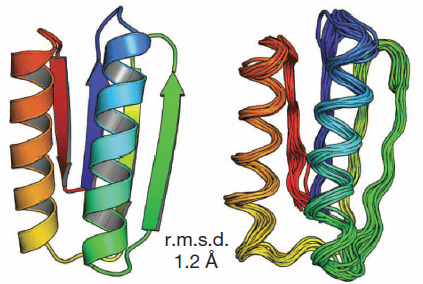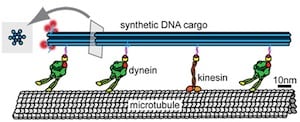A study of a biological molecular machine has shown that the machine functions most effectively when it uses chemical bonds just barely strong enough to survive the power stroke of the machine.
A study of a biological molecular machine has shown that the machine functions most effectively when it uses chemical bonds just barely strong enough to survive the power stroke of the machine.

A set of 32-nucleotide single strand DNA bricks was designed so that each can interact independently with four other DNA bricks so that sets of hundreds of bricks can self-assemble into arbitrarily complex 25-nm 3D shapes, each comprising 1000 8-base pair volume elements.
New time-resolved, high-energy Xray studies of mechanochemical (ball milling) reactions take another step toward reducing the gap between current and future machine-phase chemistry.

Five proteins were designed from scratch and found to fold into stable proteins as designed, proving the ability to provide ideal, robust building blocks for artificial protein structures.

A single-electron spin qubit on a phosphorous atom in a conventional silicon computer chip has been coherently manipulated, demonstrating the application of single atom nanotechnology to the development of a scalable platform for a quantum computer.

One possible pathway from current technology to advanced nanotechnology that will comprise atomically precise manufacturing implemented by atomically precise machinery is through adaptation and extension of the complex molecular machine systems evolved by biology. Synthetic biology, which engineers new biological systems and function not evolved in nature, is an intermediate stage along this path. An… Continue reading More complex circuits for synthetic biology lead toward engineered cells
Too much reliance on opportunity-based research could significantly hinder scientific advancement. We have the ability now to explore the specifics of potential future technologies, and the knowledge gained could, in turn, add useful and possibly surprising priorities for research today.

Sponsored by MIT Technology Review, the EmTech MIT conference covers important innovations in energy, IT, bio, and the Web, and examines their impact.

Researchers from Johns Hopkins and Northwestern Universities developed a set of shape-tunable DNA-copolymer nanoparticles that incorporate a fixed amount of DNA yet display as much as 1,680-fold difference in transfection efficiency in rat liver studies. The study may shed new light on the importance of shape in nanoparticle-based drug delivery and gene therapy.

Two types of biological molecular motors that run in opposite directions along a protein track can be used in different arrangements to either move a complex DNA cargo along the track or engage in a tug-of-war.